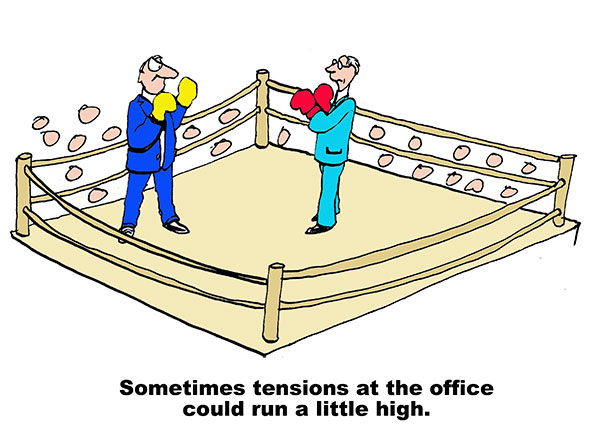Many business leaders don’t like conflict and try to sweep it under the rug, albeit unconsciously. Think about it. When conversation becomes heated during a meeting, how often have you said, “Let’s take that offline” or “Let me talk to you about that later”? Bad idea. Left unaddressed, discord can fester and become toxic, manifesting itself in disengaged employees, low productivity, and low morale. It can even escalate into workplace violence.
Yet perfect harmony isn’t what you want, either. Conflict has a positive side and can lead to greater collaboration, better decisions, and a stronger team.
The secret is to approach conflict from a learning perspective. Conflict is all about emotions, and emotions are important data. Leaders should be able to distinguish serious contention from low-level grumbling. Your goal isn’t necessarily to resolve or manage conflict, but rather to process it and derive value from it.
Diagnosing conflict
Understanding the source of conflict is helpful because it enables you to separate signal from noise. Conflict typically falls into one of three buckets:
- Internal, meaning conflict within an individual.
- Interpersonal, which occurs between two or more individuals.
- Intergroup, which occurs in more mature companies when different departments are competing with each other, such as marketing being at odds with operations.

All three forms show up in the workplace, especially for second-stage companies that are scaling. Growth requires change, and change results in conflict of varying shapes and sizes.
For example, entrepreneurs often launch their companies out of a desire for independence, along with creative and financial control. Yet as your business grows you may feel a loss of control: Your management team is doing things differently than you do; your employees aren’t acting like owners. Be aware of what you’re feeling (internal conflict) and how it impacts your thinking so you don’t over-react.
On the employee front, internal conflict often stems from having preconceived ideas about how things are going to turn out. For example, they might expect to receive a larger raise or more recognition than they’re getting. When events don’t unfold as expected, employees experience tension and act to reduce those uncomfortable feelings.
As your company grows, interpersonal and intergroup conflict will accelerate because you’re adding new people to your social system — individuals who have different needs and goals. You’re also creating more structure for the organization, which may not be welcomed by all employees. Indeed, those who have been with you since startup days may feel constrained by new processes and procedures.
Second-stage companies must also confront new questions about strategy: What new markets and customers will we pursue? What services and products are we adding? Who gets promoted? Any issue hinging on the future can be a guaranteed source of conflict.
Yes-men need not apply
Kathie Fuce-Hobohm is one second-stager who has learned to embrace conflict.
“In the past, I had a variety of nonproductive responses to conflict,” says Fuce-Hobohm, owner of SPACE Inc., an office design firm and furniture dealership in Midland, Michigan, that has nearly 40 employees and more than $20 million in annual revenue. “Primarily I would avoid it completely. I would let conflict build and when I finally confronted an issue, my dealings were highly emotional and destructive because I had waited so long.”
Now Fuce-Hobohm views conflict as “transactions,” a perspective that gives her and participants greater objectivity. Instead of approaching an issue as “I’m mad at you, I have a side and you have a side,” she now reframes the conversation as a transaction. “When we deal with transactions, we look at them from the client side first. We put our own self-interest aside and see what’s the best for the client. It completely changes the emotional response,” she says.
To reinforce this change, Fuce-Hobohm now encourages a culture of constructive conflict. “We don’t reward ‘yes,’ especially in our management team,” she explains. “You don’t get an extra hug if you’re nodding your head all the time. At the same time, when employees disagree, they need to propose an alternative solution. Saying ‘I don’t like this, I don’t like that’ is just complaining.”
Fuce-Hobohm takes a structured approach to healthy conflict by asking employees to bring up problems in Monday morning meetings, when everyone is in the room to address them. “It’s about putting the issue on the table, not the person, and coming up with solutions,” she says. Her goal is to find the best solution for the organization, and the best answer is not always the least expensive or the most popular. “We always seem to get a better answer when we’ve thrown mud at it for awhile.”
Game rules for healthy conflict
You can be a catalyst for constructive conflict. Much of it boils down to open, honest dialogue. That doesn’t happen overnight, but it gets easier when you:
- Create an environment of trust where employees know they can debate without fear of retribution.
- Set ground rules about what you’re willing to fight about. For example, doing the right thing for customers is a good topic for constructive debate, whereas dragging up events from the past is not.
- Recognize there are different responses to conflict.
Some people treat conflict like the plague, while others are eager to spar. Knowing your employees’ particular styles will help you facilitate debate, especially in meetings. As a leader you may have to tone some folks down and help other step up a bit. Make sure no one dominates the debate or is allowed to sit on the sidelines.
Granted, few entrepreneurs start their morning looking forward to a fight. But if you go through whole day without conflict you might be missing important signals. Innovation and growth don’t result from harmony; they happen when you’re able to learn from conflict.
Originally published June 25, 2014, on Inc.com (http://www.inc.com/dino-signore/how-to-take-the-con-out-of-conflict.html)
